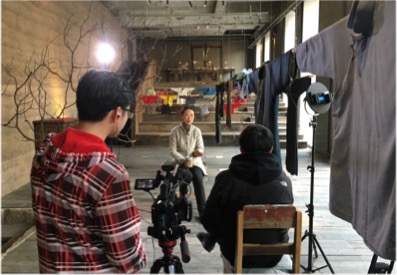
Film-makers asking one staffer to explain the aim of their unique exhibit of handmade Chinese clothes
Photo: Michael Li
BEIJING – A unique, six-month exhibition on handmade Chinese apparel has gained renewed attention at its last stage, as Figure Video, which specializing in cultural celebrities, started shooting a documentary about it at the Backstreet Art-Museum.
Duan Kun, director of the Figure Video team, said that in an era of mass-produced, machine-made clothing, they were interested in the exhibition’s theme: “Seeking Clothes for Stories.”
Indeed, the exhibition displays over 50 articles of traditional Chinese clothing, manually made of natural materials. Each is equipped with a recorder and introduction board, to describe how it was made and kept. Moreover, it explains the family stories behind the clothes themselves.
The exhibition is organized by Wuyong, an apparel company whose owner, Ma Ke, is world-renowned for being the first Chinese designer to present at Paris Haute Couture Week — and is also a favored designer of Peng Liyuan, China’s First Lady.
“Nothing would serve better than old apparel to stir family emotional memories,” said Ma, whose company, Wuyong, whose name ironically means “useless” in Chinese. “We’re helping the public restore memories about the old days of China.”
But there’s also greater symbolism involved, says Ma, who says he worries that handmade apparel left by ancestors may disappear in ten years.
“We’ve gone through an industrialized age since 1980s, resulting in a full-scale replacement of traditional clothes by manufactured T-shirts, suits and jeans,” he says. “What we’re doing now is not only about the handwork. It’s more about helping Chinese build up confidence over national culture. Without confidence we can barely keep a foothold in the world, can we?”
The exhibition opened on October 29, 2016 with a ceremony drawing nearly 400 spectators along with domestic mainstream media like China Daily and China Radio International. Gathered from all over the country, its items vary from wedding dress made by gambiered Canton gauze in 1936 to cashmere overcoat in 1980s.
One visitor, Ming Zi, said the exhibition reminds him of his aunt, who used to manually make cotton-padded trousers for him, and his mother, who was good at knitting nice sweaters.
“It evokes my nostalgia for the old times,” said Ming, 40, who’s a professional painter. “There are so many elements of Chinese traditional culture that could be applied to the design of modern dress.”